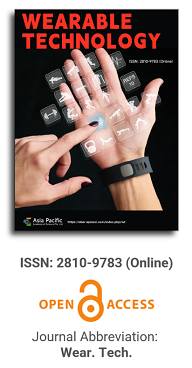

This paper delves deeply into the innovative realm of integrating human emotions with wearable technology. The primary focus is on the conceptualization and development of a kiss transfer device that harnesses the power of wearable technology to bridge the physical gap in human-human interactions. By investigating the intricate nuances of the human-human kissing process, the research seeks to replicate this intimate gesture through a technological medium. The paper not only elaborates on the anatomy, evolution, and hormonal dynamics of kissing but also underscores the transformative potential of wearable technology in capturing and transmitting these intimate moments. This exploration opens up new horizons for long-distance relationships, offering a tangible touchpoint that goes beyond traditional communication methods. Through this pioneering work, the research positions wearable technology as not just a tool for communication but as an extension of our human emotions and expressions.

Progress in the study of enzyme-free glucose electrochemical sensors
Vol 2, Issue 2, 2021
Download PDF
Abstract
The detection mechanism of enzyme-free glucose electrochemical sensors, the research progress of enzyme-free glucose sensors based on composite materials such as noble metals, transition metals and doped carbon nanomaterials, and the latest progress of new wearable enzyme-free glucose detection devices are reviewed. With the development of science and technology, enzyme-free glucose sensors will potentially be applied to the in vivo detection of animal and plant species, which will become a hot spot for new research.
Keywords
References
- Clark JRLC, Lyons C. Electrode systems for continuous monitoring in cardiovascular surgery. Annals of the New York Academy of Sciences 1962; 102(1): 29–45.
- Chen C, Xie Q, Yang D, et al. Recent advances in electrochemical glucose biosensors: A review. Rsc Advances 2013; 3(14): 4473–4491.
- Wang J. Electrochemical glucose biosensors. Chemical reviews 2008; 108(2): 814–825.
- Sehite E, Altintas Z. Significance of nanomaterials in electrochemical glucose sensors: An updated review (2016–2020). Biosensors and Bioelectronics 2020; 112165.
- Toghill KE, Compton RG. Electrochemical non-enzymatic glucose sensors: A perspective and an evaluation. International Journal of Electrochemical Science 2010; 5(9): 1246–1301.
- Burke LD. Premonolayer oxidation and its role in electrocatalysis. Electrochimica Acta 1994; 39(11–12): 1841–1848.
- Tian B, Kou Y, Jiang X, et al. Ultrasensitive determination of mercury ions using a glassy carbon electrode modified with nanocomposites consisting of conductive polymer and amino-functionalized graphene quantum dots. Microchimica Acta 2020; 187(4): 1–12.
- Mccormick W, Mccrudden D. Development of a highly nanoporous platinum screen-printed electrode and its application in glucose sensing. Journal of Electroanalytical Chemistry 2020; 860: 113912.
- Dilmac Y, Guler M. Fabrication of non-enzymatic glucose sensor dependent upon Au nanoparticles deposited on carboxylated graphene oxide. Journal of Electroanalytical Chemistry 2020; 864: 114091.
- Xu H, Xia C, Wang S, et al. Electrochemical non-enzymatic glucose sensor based on hierarchical 3D Co3O4/Ni hetero structure electrode for pushing sensitivity boundary to a new limit. Sensors and Actuators B: Chemical 2018; 267: 93–103.
- Bao L, Wu J, Dong M, et al. Preparation of enzyme-free glucose sensor by nano-nickel and zinc oxide modified copper electrodes. Journal of Materials Science and Engineering 2020; 38(2): 194–200, 261.
- Cheng S, Gao X, Delacruz S, et al. In situ formation of metal-organic framework derived CuO polyhedrons on carbon cloth for highly sensitive
- non-enzymatic glucose sensing. Journal of Materials Chemistry B 2019; 7(32): 4990–4996.
- Mishra AK, Jarwal DK, Mukherjee B, et al. Au nanoparticles modified CuO nanowireelectrode based non-enzymatic glucose detection with improved linearity. Scientific Reports 2020; 10(1): 1–10.
- Luo Y, Wang Q, Li J, et al. Tunable hierarchical surfaces of CuO derived from metal-organic frameworks for non-enzymatic glucose sensing. Inorganic Chemistry Frontiers 2020; 7(7): 1512–1525.
- Zou L, Wang S, Qiu J. Research on glucose sensor based on ionic liquid functionalized graphene/carbon nanotubes. New Carbon Materials
- ; 35(1): 12–19.
- Zhao T, Zheng K, Zheng Q, et al. Carbon nanotubes and nickel co-modified BDD electrode and its application in non-enzymatic glucose electrochemical sensor. Surface Technology 2018; 47(11): 26–33.
- Jeong H, Nguyen DM, Lee MS, et al. N-doped graphene-carbon nanotube hybrid networks attaching with gold nanoparticles for glucose non-enzymatic sensor. Materials Science and Engineering 2018; 90: 38–45.
- Xu Y. Analysis of electrochemical reduction process of graphene oxide and its application in electrocatalysis [MSc Thesis]. Jinan: Shandong University; 2015.
- Li Y. Nitrogen-doped reduced graphene oxide/multi-morphological Nano-Cu_2O electrode material and its electrochemical detection of glucose [MSc Thesis]. Taiyuan: Taiyuan University of Technology; 2017.
- Xue Y, Zeng J, Zhao L, et al. Research on persimmon tannin-reduced graphene oxide-Pt-Pd non-enzymatic blood glucose sensor. Instrument Technology and Sensors 2019; (5): 5–8, 33.
- Lee SJ, Yoon HS, Xuan X, et al. A patch type non-enzymatic biosensor based on 3D SUS micro-needle electrode array for minimally invasive continuous glucose monitoring. Sensors and Actuators B: Chemical 2016; (222): 1144–1151.
- Li B, Fan Y, Li C, et al. Online electrochemical monitoring of glucose in rat brain with acanthosphere—Like CuOOH Nanospheres-based electrochemical sensor as Non-enzymatic and O2-independent Detector. Electroanalysis 2018; 30(6): 1033–1040.
- Yoon H, Xuan X, Jeong S, et al. Wearable, robust, non-enzymatic continuous glucose monitoring system and its in vivo investigation. Biosensors and Bioelectronics 2018; (117): 267–275.
- Munje RD, Muthukumar S, Jagannath B, et al. A new paradigm in sweat based wearable diagnostics biosensors using Room Temperature Ionic Liquids (RTILs). Scientific Reports 2017; 7(1): 1–12.
- Zhu X, Ju Y, Chen J, et al. Nonenzymatic wearable sensor for electrochemical analysis of perspiration glucose. ACS Sensors 2018; 3(6): 1135–1141.
- Sedighi A, Montazer M, Mazinani S. Synthesis of wearable and flexible
- NiP0.1-SnOx/PANI/CuO/cotton towards a non-enzymaticglucose sensor. Biosensors and Bioelectronics 2019; (135): 192–199.
- Wu H, Gao W, Yin Z. Materials, devices and systems of soft bioelectronics for precision therapy. Advanced Healthcare Materials 2017; 6(10): 1700017.
Supporting Agencies
Copyright (c) 2021 Linxin Yang, Yan Wang, Jiayin Chen, Yurong Huang, Peiwen Ma, Haitao Xu

This work is licensed under a Creative Commons Attribution 4.0 International License.

Prof. Zhen Cao
College of Information Science & Electronic Engineering, Zhejiang University
China, China
Processing Speed
-
-
-
- <5 days from submission to initial review decision;
- 62% acceptance rate
-
-
Asia Pacific Academy of Science Pte. Ltd. (APACSCI) specializes in international journal publishing. APACSCI adopts the open access publishing model and provides an important communication bridge for academic groups whose interest fields include engineering, technology, medicine, computer, mathematics, agriculture and forestry, and environment.





